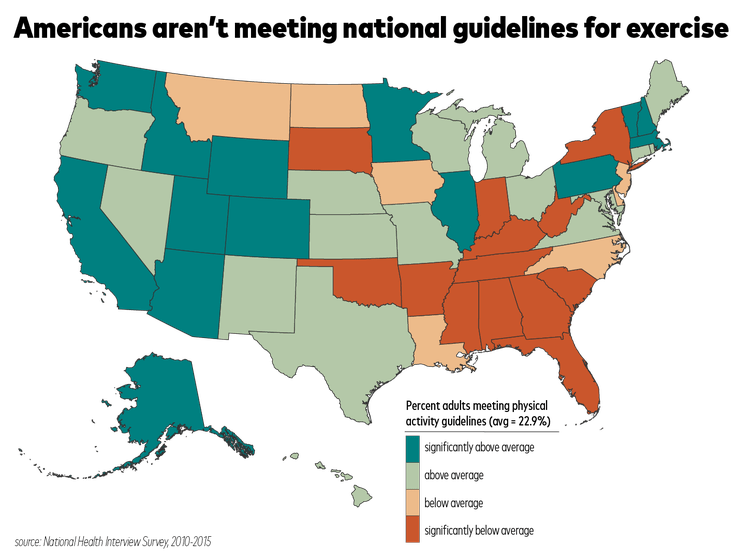
We understand that not everyone is an athlete and, in fact, not everyone intentionally workout regularly or pursue high levels of fitness. Nonetheless, people want to stay physically fit – at least fit enough to prevent obesity and avoid health issues related to a sedentary lifestyle.
How many of us actually do work out?
Well, if the data gathered by recent studies conducted by the Centers for Disease Control (CDC) are accurate (and honest!) then almost one quarter of American adults exercise to some extent.
“According to new data from the Centers for Disease Control, only about 23 percent of all U.S. adults get the recommended amount of exercise per week. That’s 150 minutes of moderate intensity aerobic exercise, plus two bouts of muscle-strengthening exercise.”
While that may seem impressive, consider that this also means over 75 percent of adults in the U.S. fail to even achieve the minimum amount of recommended exercise activity needed to stay healthy. And a large portion of that group have relatively little or no activity that could be defined as exercise, particularly aerobic activities.
State of the Fitness Union
An interesting aspect of the data gathered in these studies is that some populations tend to be far more active than others. This is true on a state-level as well as larger regional areas.
This is nicely illustrated in this graphic from a Popular Mechanics article on the subject:

[Infographic by Sara Chodosh]
Good news for those of us in California – we are significantly above average in our collective exercising efforts. And this tends to be true for most of the western states unlike those folks in the southeastern regions.
Unfortunately for pretty much everyone regardless of where they live, having to stay home as much as possible has led to an increase in inactivity and much more time spent in low-impact, low-stress activity.
In other words, far too many more people are settling into a lifestyle of sitting around, watching Netflix, eating too much, drinking too much, and doing too little exercise of any kind. However, regardless of how fit you are – or want to be – it is a known fact that lack of physical activity is hazardous to your health.
So, the question for most people is, “How much activity is enough?”
Staying Above the Threshold
The U.S. Department of Agriculture (USDA) has weighed in on this topic (no pun intended!) stating:
“Adults should do at least 2 hours and 30 minutes each week of aerobic physical activity at a moderate level OR 1 hour and 15 minutes each week of aerobic physical activity at a vigorous level. Being active 5 or more hours each week can provide even more health benefits.”
And the Department of Health and Human Services (HHS) offers their own exercise guidelines:
“For substantial health benefits, adults should do at least 150 minutes (2 hours and 30 minutes) to 300 minutes (5 hours) a week of moderate-intensity, or 75 minutes (1 hour and 15 minutes) to 150 minutes (2 hours and 30 minutes) a week of vigorous-intensity aerobic physical activity, or an equivalent combination of moderate- and vigorous-intensity aerobic activity. Preferably, aerobic activity should be spread throughout the week.
Additional health benefits are gained by engaging in physical activity beyond the equivalent of 300 minutes (5 hours) of moderate-intensity physical activity a week.
Adults should also do muscle-strengthening activities of moderate or greater intensity and that involve all major muscle groups on 2 or more days a week, as these activities provide additional health benefits.”
In addition, the HHS stresses that adults should move more and sit less throughout their day and that some physical activity is better than none. They note that people who sit less and do any amount of moderate-to-vigorous physical activity still gain some health benefits.
And what are the very real consequences of failing to attain this minimal level of physical activity?
For most Americans, obesity is a likely result. In fact, in the United States about one-third of U.S. adults are obese and approximately 12.5 million children and adolescents are obese. That’s almost two out of ten between the ages of 2 and 19 years old.
The list of major and minor diseases, conditions and dysfunctions that can occur from lack of sufficient physical activity is lengthy and distressing. To put it simply, when you are not physically active, you are at much higher risk for high blood pressure, high blood cholesterol, stroke, type 2 diabetes, heart disease and even cancer.
And there’s more. According to an article at Livestrong.com,
“If you have been sedentary for some time due to illness or injury, you may experience unpleasant side effects, such as muscle tension or muscle pain from lack of exercise. This can make performing ‘simple’ everyday activities much more difficult.”
Conditions such as muscle atrophy, disuse syndrome, and poor cardiac health are all potential results of extensive periods of inactivity or a prolonged sedentary lifestyle.
The bottom line is that regardless of the current circumstances, your long-term health and well-being is directly tied to how much physical activity you can engage in. “Stay-at-home” does not have to mean “Stay-at-rest.”
When You Need Pain and Performance Solutions
It’s been said that prevention is the best cure. And there is great truth in that, but we cannot control everything in life. If you are suffering from pain and discomfort from injuries, old or new, we invite you to contact us at Pain and Performance Solutions.
During your first appointment, we will learn all we can about your present pain and condition, along with any history of discomfort, as well as your current activity and lifestyle. We do this because to treat and relieve pain effectively, we must understand where and how your pain started.
This examination will help us determine which form of treatment is best suited to get you on your road to recovery. Your trust in us is key, as is your honesty. So, don’t hesitate to reach out. We are here to help and will answer any questions that you may have.
Our goal is to work through the sequence of pain and dysfunction so we can help your body become healthy, work properly, and achieve total recovery. Don’t hesitate to reach out. We are here to help and will answer any questions that you may have.
You can reach us at (707) 636-4404 or by filling out our online contact form.